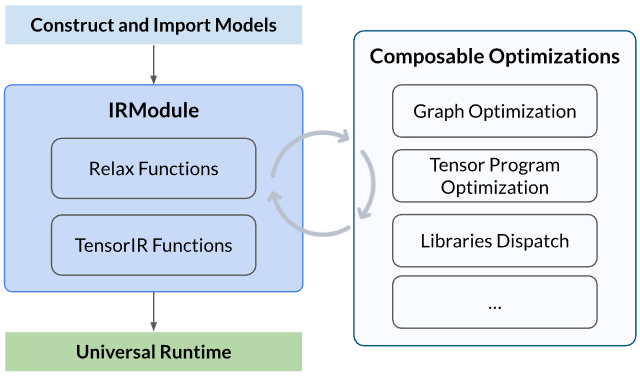源码阅读笔记
Get started
Vector Add
- define the tvm computation
- creating a schedule
- compilation and execution
# 原始程序
import numpy as np
np.random.seed(0)
n = 100
a = np.random.normal(size=n).astype(np.float32)
b = np.random.normal(size=n).astype(np.float32)
c = a + b
# 使用tvm
import tvm
for tvm import te # te stands for tensor expression
# Define the TVM compuation
def vector_add(n):
A = te.placeholder((n,), name='a')
B = te.placeholder((n,), name='b')
C = te.compute(A.shape, lambda i: A[i] + B[i], name='c')
return A, B, C
A, B, C = vector_add(n)
# Creating a schedule
s = te.create_schedule(C.op)
tvm.lower(S, [A, B, C], simple_mode=True)
# Compilation and execution
mod = tvm.build(s, [A, B, C]) # compiles to machine codes
a, b, c = get_abc(100, tvm.nd.array)
mod(a, b, c)
np.testing.assert_array_equal(a.asnumpy() + b.asnumpy(), c.asnumpy())
Neural Network Inference
relay module in TVM to convert and optimize a neural network. Relay is the high-level intermediate representation (IR) in TVM to represent a neural network.
import numpy as np
import mxnet as mx
from PIL import Image
import tvm
from tvm import relay
model = mx.gluon.model_zoo.vision.resnet18_v2(pretrained=True)
# Pre-processing Data
image = Image.opern('../data/cat.jpg').resize((224, 224))
def image_preprocessing(image):
image = np.array(image) - np.array([123., 117., 104.])
image /= np.array([58.395, 57.12, 57.375])
image = image.transpose((2, 0, 1))
image = image[np.newaxis, :]
return image.astype('float32')
x = image_preprocessing(image)
# Compile Pre-trained Models 目前仅支持静态图操作,不支持动态图
relay_mod, relay_params = relay.frontend.from_mxnet(model, {'data', x.shape})
target = 'llvm'
with relay.build_config(opt_level=3):
graph, mod, params = relay.build(relay_mod, target, params=relay_params) # graph描述神经网络、mod代表编译算子、params代表权重参数
# Inference
ctx = tvm.context(target)
rt = tvm.contrib.graph_runtime.create(graph, mod, ctx)
rt.set_input(**params)
rt.run(data=tvm.nd.array(x))
scores = rt.get_output(0).asnumpy()[0]
# Saving the compiled library
name = 'resnet18'
graph_fn, mod_fn, params_fn = [name+ext for ext in ('.json', '.tar', '.params')]
mod.export_library(mod_fn)
with open(graph_fn, 'w') as f:
f.write(graph)
with open(params_fn, 'wb') as f:
f.write(relay.save_param_dict(params))
loaded_graph = open(graph_fn).read()
loaded_mod = tvm.runtime.load_module(mod_fn)
loaded_params = open(params_fn, "rb").read()
loaded_rt = tvm.contrib.graph_runtime.create(loaded_graph, loaded_mod, ctx)
loaded_rt.load_params(loaded_params)
loaded_rt.run(data=tvm.nd.array(x))
loaded_scores = loaded_rt.get_output(0).asnumpy()[0]
tvm.testing.assert_allclose(loaded_scores, scores)
Expression for Operators
Data Types
import tvm
from tvm import te
import numpy as np
n = 100
def tvm_vector_add(dtype):
A = te.placeholder((n,), dtype=dtype)
B = te.placeholder((n,), dtype=dtype)
C = te.compute(A.shape, lambda i: A[i] + B[i])
print('expressiuon dtype:', A.dtype, B.dtype, C.dtype)
s = te.create_schedule(C.op)
return tvm.build(s, [A, B, C])
def test_mod(mod, dtype):
a, b, c = d2ltvm.get_abc(n, lambda x: tvm.nd.array(x.astype(dtype)))
mod(a, b, c)
np.testing.asser_equal(c.asnumpy(), a.asnumpy() + b.asnumpy())
for dtype in ['float16', 'float64', 'int8', 'int16', 'int64']:
mod = tvm_vector_add(dtype)
test_mod(mod, dtype)
Converting Elements Data Types
常用函数
tvm.te.placeholder: declare the placeholders A and B for both inputs by specifying theirs shapes
tvm.compute: compute
tvm.create_schedule: how to execute the program, for example, the order to access data and how to do multi-threading parallelization
tvm.lower:
tvm.build: compile them into an executable module
tvm.nd.array: convert data type
relay_mod, relay_params = relay.fronted.from_mxnet(model {'data': x.shape}):
graph, mod, params = relay.build(relay_mod, target, params=relay_params):
ctx = tvm.context(target):
rt = tvm.contrib.graph_runtime.create(graph, mod, ctx):
rt.set_input(**params):
rt.run(data=tvm.nd.array(x)):
te.var: create a symbolic variable for an int32 scalar
tvm.reduce_axis: create an axis for reduction with range from 0 to m
tvm.comm_reducer: a customized commutative reduction operator
官方教程
Design and Architecture
Overall Flow: model creation、transformation、target translation、runtime execution

-
Key data structures: IRModule(realx::Function、tir::PrimFunc) -
Transformations: relax transformations(common graph-level optimizations)、tir transformations(TensorIR schedule、Lowering Passes)、cross-level transformations Targete TranslationRuntime Execution